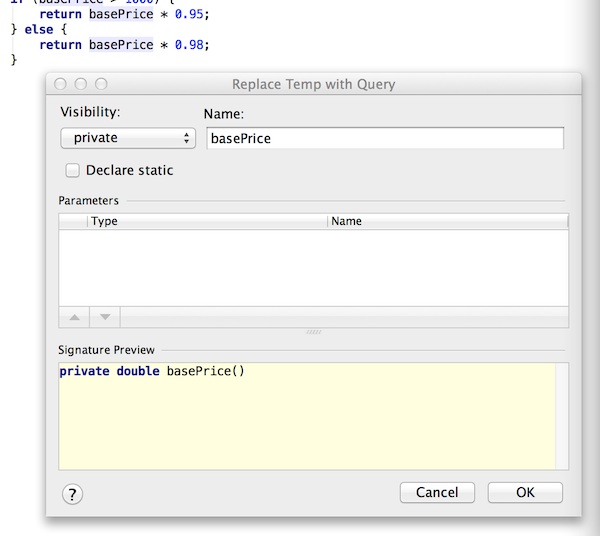- 改善 GitHub 项目代码质量:重构
- 为什么重构?
- 重构uMarkdown
- 代码说明
- Intellij Idea重构
- Rename
- Extract Method
- Inline Method
- Pull Members Up
- 重构之以查询取代临时变量
- 重构之前
- 重构
- Intellij IDEA重构
改善 GitHub 项目代码质量:重构
或许你应该知道了,重构是怎样的,你也知道重构能带来什么。在我刚开始学重构和设计模式的时候,我需要去找一些好的示例,以便于我更好的学习。有时候不得不创造一些更好的场景,来实现这些功能。
有一天,我发现当我需要我一次又一次地重复讲述某些内容,于是我就计划着把这些应该掌握的技能放到GitHub上,也就有了Artisan Stack 计划。
每个程序员都不可避免地是一个Coder,一个没有掌握好技能的Coder,算不上是手工艺人,但是手工艺人,需要有创造性的方法。
为什么重构?
为了更好的代码。
在经历了一年多的工作之后,我平时的主要工作就是修Bug。刚开始的时候觉得无聊,后来才发现修Bug需要更好的技术。有时候你可能要面对着一坨一坨的代码,有时候你可能要花几天的时间去阅读代码。而你重写那几十行代码可能只会花上你不到一天的时间。但是如果你没办法理解当时为什么这么做,你的修改只会带来更多的Bug。修Bug,更多的是维护代码。还是前人总结的那句话对:
写代码容易,读代码难。
假设我们写这些代码只要半天,而别人读起来要一天。为什么不试着用一天的时候去写这些代码,让别人花半天或者更少的时间来理解。
如果你的代码已经上线,虽然是一坨坨的。但是不要轻易尝试没有测试的重构。
从前端开始的原因在于,写得一坨坨且最不容易测试的代码都在前端。
让我们来看看我们的第一个训练,相当有挑战性。
重构uMarkdown
代码及setup请见github: js-refactor
代码说明
uMarkdown是一个用于将Markdown转化为HTML的库。代码看上去就像一个很典型的过程代码:
/* code */while ((stra = micromarkdown.regexobject.code.exec(str)) !== null) {str = str.replace(stra[0], '<code>\n' + micromarkdown.htmlEncode(stra[1]).replace(/\n/gm, '<br/>').replace(/\ /gm, ' ') + '</code>\n');}/* headlines */while ((stra = micromarkdown.regexobject.headline.exec(str)) !== null) {count = stra[1].length;str = str.replace(stra[0], '<h' + count + '>' + stra[2] + '</h' + count + '>' + '\n');}/* mail */while ((stra = micromarkdown.regexobject.mail.exec(str)) !== null) {str = str.replace(stra[0], '<a href="mailto:' + stra[1] + '">' + stra[1] + '</a>');}
选这个做重构的开始,不仅仅是因为之前在写EchoesWorks的时候进行了很多的重构。而且它更适合于重构到设计模式的理论。让我们在重构完之后,给作者进行pull request吧。
Markdown的解析过程,有点类似于Pipe and Filters模式(架构模式)。
Filter即我们在代码中看到的正规表达式集:
regexobject: {headline: /^(\#{1,6})([^\#\n]+)$/m,code: /\s\`\`\`\n?([^`]+)\`\`\`/g
他会匹配对应的Markdown类型,随后进行替换和处理。而``str```,就是管理口的输入和输出。
接着,我们就可以对其进行简单的重构。
(ps: 推荐用WebStrom来做重构,自带重构功能)
作为一个示例,我们先提出codeHandler方法,即将上面的
/* code */while ((stra = micromarkdown.regexobject.code.exec(str)) !== null) {str = str.replace(stra[0], '<code>\n' + micromarkdown.htmlEncode(stra[1]).replace(/\n/gm, '<br/>').replace(/\ /gm, ' ') + '</code>\n');}
提取方法成
codeFilter: function (str, stra) {return str.replace(stra[0], '<code>\n' + micromarkdown.htmlEncode(stra[1]).replace(/\n/gm, '<br/>').replace(/\ /gm, ' ') + '</code>\n');},
while语句就成了
while ((stra = regexobject.code.exec(str)) !== null) {str = this.codeFilter(str, stra);}
然后,运行所有的测试。
grunt test
同理我们就可以mail、headline等方法进行重构。接着就会变成类似于下面的代码,
/* code */while ((execStr = regExpObject.code.exec(str)) !== null) {str = codeHandler(str, execStr);}/* headlines */while ((execStr = regExpObject.headline.exec(str)) !== null) {str = headlineHandler(str, execStr);}/* lists */while ((execStr = regExpObject.lists.exec(str)) !== null) {str = listHandler(str, execStr);}/* tables */while ((execStr = regExpObject.tables.exec(str)) !== null) {str = tableHandler(str, execStr, strict);}
然后你也看到了,上面有一堆重复的代码,接着让我们用JavaScript的奇技淫巧,即apply方法,把上面的重复代码变成。
['code', 'headline', 'lists', 'tables', 'links', 'mail', 'url', 'smlinks', 'hr'].forEach(function (type) {while ((stra = regexobject[type].exec(str)) !== null) {str = that[(type + 'Handler')].apply(that, [stra, str, strict]);}});
进行测试,blabla,都是过的。
Markdown✓ should parse h1~h3✓ should parse link✓ should special link✓ should parse font style✓ should parse code✓ should parse ul list✓ should parse ul table✓ should return correctly class name
快来试试吧, https://github.com/artisanstack/js-refactor
是时候讨论这个Refactor利器了,最初看到这个重构的过程是从ThoughtWorks郑大晔校开始的,只是之前对于Java的另外一个编辑器Eclipse的坏感。。这些在目前已经不是很重要了,试试这个公司里面应用广泛的编辑器。
Intellij Idea重构
开发的流程大致就是这样子的,测试先行算是推荐的。
编写测试->功能代码->修改测试->重构
上次在和buddy聊天的时候,才知道测试在功能简单的时候是后行的,在功能复杂不知道怎么下手的时候是先行的。
开始之前请原谅我对于Java语言的一些无知,然后,看一下我写的Main函数:
package com.phodal.learing;public class Main {public static void main(String[] args) {int c=new Cal().add(1,2);int d=new Cal2().sub(2,1);System.out.println("Hello,s");System.out.println(c);System.out.println(d);}}
代码写得还好(自我感觉),先不管Cal和Cal2两个类。大部分都能看懂,除了c,d不知道他们表达的是什么意思,于是。
Rename
快捷键:Shift+F6
作用:重命名
- 把光标丢到int c中的c,按下shift+f6,输入result_add
- 把光标移到int d中的d,按下shift+f6,输入result_sub
于是就有
package com.phodal.learing;public class Main {public static void main(String[] args) {int result_add=new Cal().add(1,2);int result_sub=new Cal2().sub(2,1);System.out.println("Hello,s");System.out.println(result_add);System.out.println(result_sub);}}
Extract Method
快捷键:alt+command+m
作用:扩展方法
- 选中System.out.println(result_add);
- 按下alt+command+m
- 在弹出的窗口中输入mprint
于是有了
public static void main(String[] args) {int result_add=new Cal().add(1,2);int result_sub=new Cal2().sub(2,1);System.out.println("Hello,s");mprint(result_add);mprint(result_sub);}private static void mprint(int result_sub) {System.out.println(result_sub);}
似乎我们不应该这样对待System.out.println,那么让我们内联回去
Inline Method
快捷键:alt+command+n
作用:内联方法
- 选中main中的mprint
- alt+command+n
- 选中Inline all invocations and remove the method(2 occurrences) 点确定
然后我们等于什么也没有做了~~:
public static void main(String[] args) {int result_add=new Cal().add(1,2);int result_sub=new Cal2().sub(2,1);System.out.println("Hello,s");System.out.println(result_add);System.out.println(result_sub);}
似乎这个例子不是很好,但是够用来说明了。
Pull Members Up
开始之前让我们先看看Cal2类:
public class Cal2 extends Cal {public int sub(int a,int b){return a-b;}}
以及Cal2的父类Cal
public class Cal {public int add(int a,int b){return a+b;}}
最后的结果,就是将Cal2类中的sub方法,提到父类:
public class Cal {public int add(int a,int b){return a+b;}public int sub(int a,int b){return a-b;}}
而我们所要做的就是鼠标右键
重构之以查询取代临时变量
快捷键
Mac: 木有
Windows/Linux: 木有
或者: Shift+alt+command+T 再选择 Replace Temp with Query
鼠标: Refactor | Replace Temp with Query
重构之前
过多的临时变量会让我们写出更长的函数,函数不应该太多,以便使功能单一。这也是重构的另外的目的所在,只有函数专注于其功能,才会更容易读懂。
以书中的代码为例
import java.lang.System;public class replaceTemp {public void count() {double basePrice = _quantity * _itemPrice;if (basePrice > 1000) {return basePrice * 0.95;} else {return basePrice * 0.98;}}}
重构
选中basePrice很愉快地拿鼠标点上面的重构

便会返回
import java.lang.System;public class replaceTemp {public void count() {if (basePrice() > 1000) {return basePrice() * 0.95;} else {return basePrice() * 0.98;}}private double basePrice() {return _quantity * _itemPrice;}}
而实际上我们也可以
选中
_quantity * _itemPrice
对其进行
Extrace Method选择
basePrice再Inline Method
Intellij IDEA重构
在Intellij IDEA的文档中对此是这样的例子
public class replaceTemp {public void method() {String str = "str";String aString = returnString().concat(str);System.out.println(aString);}}
接着我们选中aString,再打开重构菜单,或者
Command+Alt+Shift+T 再选中Replace Temp with Query
便会有下面的结果:
import java.lang.String;public class replaceTemp {public void method() {String str = "str";System.out.println(aString(str));}private String aString(String str) {return returnString().concat(str);}}
